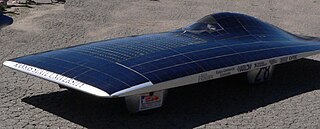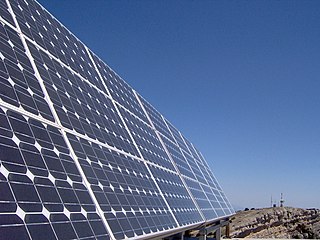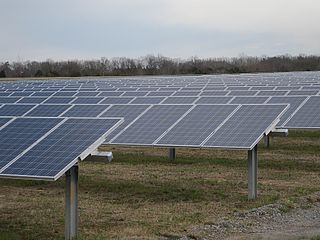
Solar power in Connecticut establishes Connecticut as the second state in the US to reach grid parity, after Hawaii, due to the high average cost of electricity. Installing solar panels for a home provides an estimated 15.6% return on investment.

Solar power in Nebraska is used for only a very small percentage of the state's electricity, although it is rapidly becoming competitive with grid electricity, due to the decrease in cost and the 30% tax credit, which can be used to install systems of any size. In 2024, the state ranked 44th among the 50 U.S. states with 203 MW of installed capacity.

Solar power in South Carolina is rapidly becoming competitive with grid electricity, due to the decrease in cost and the eight-year extension to the 30% federal tax credit, which can be used to install any size system. South Carolina offers a 25% tax credit, meaning that 55% of the cost is covered through tax credits.

Solar power in Kentucky has been growing in recent years due to new technological improvements and a variety of regulatory actions and financial incentives, particularly a 30% federal tax credit, available through 2016, for any size project. Kentucky could generate 10% of all of the electricity used in the United States from land cleared from coal mining in the state. Covering just one-fifth with photovoltaics would supply all of the state's electricity.

Solar power in Wyoming has the potential to generate 72 million MWh/yr. Wyoming used 12 million MWh in 1999. Net metering is available to all consumers generating up to 25 kW. The state has an installed capacity of 146 MW as of 2022.

Solar power in Indiana has been growing in recent years due to new technological improvements and a variety of regulatory actions and financial incentives, particularly a 30% federal tax credit for any size project.

Solar power in Kansas has been growing in recent years due to new technological improvements and a variety of regulatory actions and financial incentives.

Solar power in Alaska has been primarily used in remote locations, such as the Nenana Teen Center near Fairbanks, where long summer days provide most of the electricity generated. In 2015, Alaska ranked 45th in installed solar among U.S. states. Rooftop solar panels could provide 23% of all electricity used in Alaska. Net metering is available for PV systems up to 25 kW but is limited to 1.5% of average demand. IREC best practices, based on experience, recommends no limits to net metering, individual or aggregate, and perpetual roll over of kWh credits.

Solar power in Iowa is limited but growing, with 137 megawatts (MW) installed by the end of 2019 and 27 MW installed during that year, ranking the state 40th among U.S. states. Iowa also generated 0.23% of the state's total electricity production in 2019 from solar energy; an amount sufficient to power over 17,000 Iowa homes. The state's early position as a major wind-power provider may have limited early large-scale solar investment.
Solar power in North Dakota has been a little-used resource. The state ranks last on installed solar power in the United States, with .47 MW of installed capacity. Solar on rooftops can provide 24.6% of all electricity used in North Dakota from 3,300 MW of solar panels. The most cost effective application for solar panels is for pumping water at remote wells where solar panels can be installed for $800 vs. running power lines for $15,000/mile.

Solar power in South Dakota has high potential but little practical application. The state ranked 50th among U.S. states in installed solar polar in 2015 with no utility-scale or large commercial systems. Photovoltaic panels on rooftops can provide 38.7% of all electricity used in South Dakota using 3,800 MW of solar panels. The state is ranked 14th in the country in solar power potential, and 4th in wind potential.

Mississippi has substantial potential for solar power, though it remains an underutilized generation method. The rate of installations has increased in recent years, reaching 438 MW of installed capacity in early 2023, ranking 36th among the states. Rooftop photovoltaics could provide 31.2% of all electricity used in Mississippi from 11,700 MW if solar panels were installed on every available roof.

Solar power in Illinois has been increasing, as the cost of photovoltaics has decreased. As of the end of 2020, Illinois had 465 megawatts (MW) of installed photovoltaic and concentrated solar power capacity combined employing over 5,200 jobs. Illinois adopted a net metering rule which allows customers generating up to 40 kW to use net metering, with the kilowatt hour surplus rolled over each month, and lost at the end of either April or October, as selected by the customer. In 2011, the limit was raised to 2 MW, but is not net metering, as the term is commonly known, as it uses two meters for systems larger than 40 kW.

Solar power in Minnesota expanded significantly in the early 2010s as a result of the cost decrease of photovoltaics and favorable policies. By 2016, it began to grow quickly.

Solar power in Maryland is supported by the state's legislation regarding the Renewable Portfolio Standard and Solar Renewable Energy Credit (SREC) program. The target for renewable energy as of 2017 is 20% by 2020, including 2% from solar power.

Solar power in Idaho comprised 550 MW in 2019. A 2016 report by the National Renewable Energy Laboratory estimated that rooftops alone have the potential to host 4,700 MW of solar panels, and thus provide 26.4% of all electricity used in Idaho. A large increase in the state's solar generating capacity began starting year 2015 when 461 MW of solar power was contracted to be built in Idaho.

Solar power in Montana on rooftops could provide 28% of all electricity used in Montana from 3,200 MW of solar panels.

Solar power in Vermont provides almost 11% of the state's in-state electricity production as of 2018. A 2009 study indicated that distributed solar on rooftops can provide 18% of all electricity used in Vermont. A 2012 estimate suggests that a typical 5 kW system costing $25,000 before credits and utility savings will pay for itself in 10 years, and generate a profit of $34,956 over the rest of its 25-year life.

Solar power in Wisconsin In 2026, Wisconsin rooftops can accommodate approximately 37 GWs of solar capacity and produce 44,183 GWh of electricity, nearly 70% of the statewide generation in 2019. Net metering is available for systems up to at least 20 kW, and excess generation is credited at retail rate to customers next bill. Some utilities allow net metering up to 100 kW. For Xcel customers, kilowatt credits are rolled over monthly and are reconciled annually at avoided cost. Best practices recommend no limits, either individually or aggregate, and perpetual roll over of kilowatt credits.

Solar power in Tennessee is capable of producing much of the state's electricity; however, the industry remains in early stages in the state. With 129 MW of solar power in 2015, Tennessee ranked 20th among states for installed solar capacity.





















